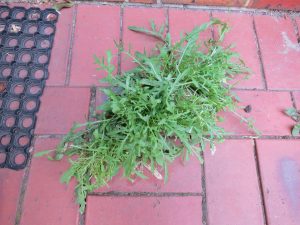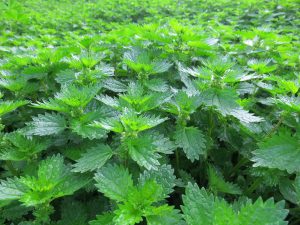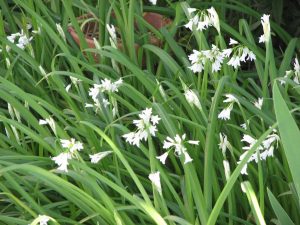Weed foraging is the age old tradition of learning to identify and use edible weeds as a nutritious ingredient for your meals, salads and herbal teas. Weeds can be foraged from your garden, neighbouring properties or from public green spaces, turning a problem into a solution.
Please note that this is an introduction to weed foraging based on our limited experience and should not be taken as expert advice (nor should you go weed foraging based on this article alone).
If you want to try your hand at foraging, get a good book first and study it well (The Weed Forager’s Handbook by Adam Grubb and Annie Raser-Rowland is great for learning about common edible and medicinal weeds in Australia) and if possible in your area, consider learning from a more experienced forager either informally or through a workshop or organised group.
So why would you want to eat weeds?
- The word “weed” is subjective; Many so-called “weeds” have been traditionally used for human consumption and medicinal purposes.
- Weeds have the characteristics of “pioneer species” meaning that they take hold in highly damaged earth in order to repair it and create a habitat for other species to move back in.
- Most edible weeds are leafy greens and are highly nutritious, in fact dandelion, as an example, is the most nutritious vegetable ever tested by the US Department of Agriculture.
- Edible weeds (like any weed) grow in places where other plants will not, like the cracks in your concrete pavers or can be sourced for free from public areas.
- When picked at the right time, edible weeds also exhibit great flavours to add to your culinary menu.
- Turning edible weeds into a solution turns weeding the garden from a chore into a pleasure.

What abour precautions?
- Certain weeds can be very toxic potentially causing death if ingested or other undesired symptoms like skin rash.
- For inexperienced foragers, it can be hard to differentiate between poisonous plants and edible ones that look similar.
- Because of this, do not eat any plant unless you are 100% sure you know what it is which is why we highly recommend using a good book (with good photos to assist with successful plant identification) and if possible, learning from an expert or someone more experienced.
- Experts recommend starting out with one or two common varieties and then slowly building from there to develop your skills as a weed forager.
- As an example, we started with dandelion and nettle because they are easy to safely identify, they grow in our area and are great in pestos, salads and herbal teas.

- Some edible weeds have edible parts and poisonous parts so in this case, you also need to learn which parts you can safely use.
- It is also important to note that some edible weeds may not be suitable for certain people to ingest (e.g. plants containing strong flavour compounds for pregnant women/women trying to conceive or nitrate accumulators for infants) which again, underlines the importance of seeking expert advice.
- When adding a new food to your diet, start with small quantities to give your digestion and taste buds time to adjust.
- If foraging in public areas, check your local laws to see if your local council has sprayed weeds with herbicides and if they mark these areas with signs or dye (obviously, you don’t want to ingest weeds that have been sprayed with herbicide).
- Be mindful that weeds in certain areas may be contaminated by pollutants including traffic exhaust fumes, polluted water, industrial pollution and lead paint contamination.
- Don’t let the risks put you off; any activity where you take responsibility for learning to meet your own needs has risks, it’s just important to learn how to manage these risks safely.
Is it worth all of this effort?

“IMG_0131” by misterlevel is licensed under CC BY-NC-ND 2.0
- Along with many other people who traditionally foraged for weeds or more recently are reviving this lost art, we think it’s worth the effort.
- In line with expert advice, we have found that the young and tender leaves on edible weeds are the best to eat (especially before flowering) and that stems should be avoided.
- An hours work picking nettles in a field on a nice winters morning plus an hour of spreading them onto drying racks and blanching some got us over a year’s supply of delicious nettle tea plus 9 jars of nettle pesto (nettle loses its sting when blanched, dried or cooked and tastes similar to spinach) saving us $150.
- Though some still get pulled out, weeds are generally now useful to us and when they show up in the garden they can give us valuable feedback about soil and moisture conditions or provide some natural pest control.
- Our walks have become more enjoyable as we have learnt to identify some common weeds in our area plus through an edible weed walk we discovered the delights of varieties like wild onion and prickly pear.
- We now know that there is a free source of greens that grow with no effort beyond the boundaries of our home, in fact we have only just hit the tip of the iceberg.
- Again, we can slowly build our knowledge as time allows whilst sticking with using edible weeds that we can safely identify and use.
With the above precautions in mind, weed foraging is a great way to turn edible weeds in your garden or beyond into a source of nutritious and tasty greens or for medicinal uses. Get a good book and if possible, learn from an expert or experienced forager to compliment your garden with a free source of greens and to satisfy your inner hunter gatherer.